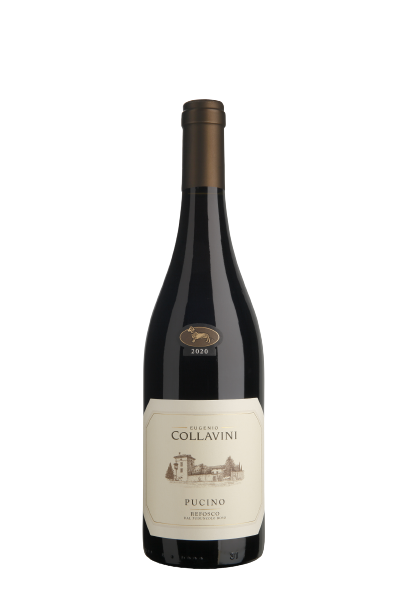Red Wines
A well-balanced, elegant style characterises the structure and body of these timeless red wines, capable of conveying all the richness of Friuli’s terroirs.

PIGNOLO
“A singular kind of wine: a luxury”: that is how it was defined in 1930 by Professor Dalmasso.
This is a red made from indigenous grapes, collected on trays and placed in our loft to dry for 20 days at low temperature. The bunches are then destemmed, and fermentation takes place on the skins for around three weeks.
In the spring following the harvest, a long period of maturation in barriques takes place, for about 5 years. This lengthy process concludes with bottle-ageing for at least 2 years. Well-known for its longevity, in fine vintages Pignolo can even be aged for over twenty years, offering a wine that is still rich and elegant.
A fine red wine that is ideal with the traditional meat dishes of Italian and Friulian cuisine.
In the glass, it displays a deep, opaque ruby hue. Its nose reveals its multi-faceted character. Hints of very ripe small red fruits and marasca cherries mingle with incense, old wood, undergrowth and dark chocolate. The spicy notes become more prominent with age. On the palate it is powerful, broad and very warming, with notable but very well-balanced tannins.
This is a wine that, with its structure, offers great emotions when young, but especially after some twenty years in the bottle.

MERLOT DAL PIC
Our Merlot takes its name from the Friulian expression “Dal Pic”, which corresponds to the summit of a hill, the zone of high ground with the best exposure. Here the grapes attain full ripeness and, at harvest time, are picked and placed in our drying loft. Under controlled conditions of temperature and humidity, the aromas and taste characteristics of each bunch become more concentrated.
After pressing, there follows maceration on the skins for 20 days and, beginning in the spring following the harvest, the wine matures in Allier and Tronçais barriques for at least 24 months. Two years’ bottle-ageing completes the process.
Try it with red meats and game (such as wild boar or venison); excellent with goat’s milk cheeses and mature cow’s milk ones. It is at its very best when paired with a leg of roe deer.
A deep ruby red colour, with still purplish reflections. It is a complex, concentrated and intense wine which, on the nose, clearly displays notes of wild berry fruits, spices and liquorice. The fruity sensations are echoed on the palate, mingling with the warmth and mellowness that are typical of Merlot and closing with well-integrated tannins that intensify the persistence of flavour.

FORRESCO
A blend of Refosco dal Peduncolo Rosso, Refosco di Faedis and Pignolo, in a wine with an impenetrable ruby red colour.
The ripe grapes are laid out on trays in our drying loft to concentrate their aromas and flavours. They are then destemmed and maceration on the skins takes place for three weeks in automated and temperature-controlled vinification tanks. Our Forresco then continues its voyage in Allier and Tronçais barriques, where it remains for 24 months. This is followed by final maturation in bottle for a total of 2 years.
Excellent with red meat dishes, whether grilled, roast or slowly stewed.
Its dense, rich ruby red colour conceals a wine with extraordinary complexity on the nose, offering evident and intense suggestions of redcurrants, wild blackberries and plums. All of this is amplified in the mouth, with balsamic and spicy sensations that coat and surprise the palate. The tannins on the finish give added persistence, leaving the drinker wanting to take another sip.

TURIAN SCHIOPPETTINO
After the harvest, the Schioppettino (also known as Ribolla Nera) grapes rest for a few days in our drying loft. This is followed by fermentation on the skins for around 3 weeks in small automated and temperature-controlled stainless steel vinification tanks.
Eighteen months’ maturation in Allier barriques are followed by a further 18 months in bottle: a winemaking voyage lasting three years, which eventually produces our Turian.
The food pairings are numerous, from refined game birds to pappardelle with hare, wild boar or roe deer sauces. Ideal with roast “masurin” (mallard) or goose cooked with horseradish and served with fig mostarda.
The wine displays an intense ruby red colour with still purplish nuances. It is evolved, complex and concentrated on the nose, with varietal characteristics that translate into notes of raspberries, balckberries, black pepper and spices. Its flavour is shrouded in soft tannins, with a freshness that adds vivacity to the long, persistent finish.

REFOSCO PUCINO
Refosco Pucino is our interpretation of an indigenous Friulian variety that was already documented in Roman times, and from which it takes its name.
The grapes are first of all destemmed and are then macerated on the skins for a week at a temperature of just 4°C. After a brief fermentation in stainless steel vinification tanks, maturation continues until the spring in stainless steel containers.
It is our tradition to always only bottle this wine in the spring.
Particularly recommended with white meat recipes, it also goes well with fish and tomato soups and certain fish dishes, such as eel, turbot and oily fish in general. Try it with the typical boreto alla gradese.
A deep ruby red with marked purplish highlights gives prior notice of the freshness and vinous sensations that are typical of Refosco. The fruity varietal notes of brambles and raspberries mingle with delicate hints of liquorice. On the palate it is well-balanced and rounded, underpinned by a faintly herbaceous vein in the background.

PONCANERA MERLOT
The grapes, after careful selection and picking by hand, ferment on the skins for over two weeks in temperature-controlled, automated vinification tanks. Maturation, from the spring following the harvest onwards, is completed in pre-used oak casks, a process that adds structure and body to the wine.
It expresses itself at its best with roasted, fried or stewed white meats (particularly rabbit, poultry, veal and pork). Ideal for accompanying one of the typical dishes of Friuli’s cuisine: rabbit loin with aromatic herbs.
Here too, one is struck by its ruby red colour, which stands out with its faintly garnet shade. On the nose it is vinous and a little herbaceous, with suggestions of raspberries and wild blackberries. Dry, complex and mellow, on the palate one appreciates its well-integrated tannins and the marked persistence of the fruit.

RONCACCIO CABERNET
From the hills and gravelly magredi on the plain of Friuli Venezia Giulia comes our Roncaccio, Collavini’s interpretation of Cabernet Sauvignon.
The grapes, destemmed and then placed in stainless steel vinification tanks, carry on their fermentation on the skins for around two weeks. Maturation begins in the spring, taking place in pre-used oak casks.
Excellent with rich meat recipes, such as roasts of white and red meats, refined poultry dishes and game. It is also excellent with a nice selection of hard, very mature cheeses. A special pairing? Try it with a slice of salami and a drop of balsamic vinegar.
This Cabernet Sauvignon is ruby red with purplish highlights in colour, and is vegetal and vinous on the nose. Its fruity notes on the palate combine with intense tannins and a satisfying tanginess, finishing with a velvety, vanilla-like aftertaste.

MORE
MoRe is a blend that combines the roundedness of Merlot with the character of Refosco. And it is indeed by uniting some of the letters in the names of these wines that our MoRe takes its name.
The Refosco grapes, harvested in trays and then placed in our drying loft to enhance the variety’s body and aromas, ferment for around 15 days in temperature-contolled stainless steel vinification tanks. Maturation continues for a year in small, pre-used oak casks.
Ottimo con le carni rosse, proposte in umido, al forno o alla griglia.
It displays a deep ruby red colour, with marked purplish highlights. The nose offers complex, fruity and spicy aromas, with evident hints of undergrowth, tobacco and liquorice. On the palate, one is struck by the wine’s structure, fruit and persistence. The tannins are rich, but skilfully balanced by the measured mellowness of the fruit.
